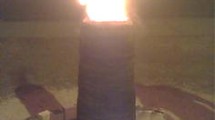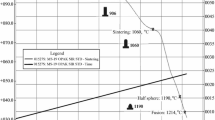Abstract
Ceramic tools were made in lowland Mesopotamia from about 4500 to 2750 B.C.E. At first hammers, adzes, axes and sickles were made. By about 3300-3100 B.C.E., only sickles were made. We reverse engineered the technology to show that local, salty montmorillonite clay and quartz sand were formed into a composite blade and handle from a biconical coil and fired to 1120-1170°C based on analysis of refiring tests. At 1200°C the montmorillonite clay transforms to glass, so the firing range was right on the edge of slumping the ceramic into a useless mass. To prevent plastic deformation of the clay about 25-33 vol% of quartz sand was added. The extensive glassy matrix phase enabled the best blades to be resharpened by pressure flaking. The compositions, phase assemblage, firing temperature range, material limits on processing, and properties have been characterized for 15 sickle samples from Nippur using Xeroradiography, SEM-EDS, EPMA, and analysis of refiring tests. Strength and hardness tests and toughness calculations were conducted on replicate test tiles made using clay from Pit M at Nippur, Iraq, and sand.
Based on finds of small groups of well-fused sickles that were overfired and melted together and our experiments that demonstrated the difficulty of controlling peak temperature range and firing time for the somewhat variable raw material, the sickles probably were fired in small groups, of perhaps 10-15, in small arched, tunnel kilns that achieved high temperatures by facing somewhat predictable oncoming wind flows that provided natural draft. No evidence of workshops has been located, but, based on the archaeological finds at Nippur and our analyses, we propose that sickle-making may have been practiced as a local, seasonal, popular technology with tools being made by farmers or part-time specialists who fired in small, temporary tunnel kilns in fields or near settlements during the dependable seasonal winds. This research investigated the sickles as a well-engineered, but risk-prone ceramic manufacture that fulfilled an important a societal need, agricultural success. The technological choices of craftsmen were narrowed by raw material constraints, risk-taking, practice and workmanship to achieve desired properties and performance characteristics.
Similar content being viewed by others
References
P. Buringh, Soils and Soil Conditions in Iraq, Ministry of Agriculture, Republic of Iraq, Baghdad, Iraq, pp. 13–54 (1960).
T. Wilkinson, Archaeological Landscapes of the Near East, University of Arizona Press, Tucson, pp. 76–91 (2003).
Donny George (personal communication).
R. McC. Adams and H.J. Nissen, The Uruk Countryside: The Natural Setting of Urban Societies, University of Chicago Press, pp. 208–210 (1972).
N.L. Benco, “Manufacture and Use of Clay Sickles from the Uruk Mound, Abu Salabikh, Iraq.” Paléorient, vol. 18, no. 1, pp. 119–134 (1992).
P.R.S. Moorey, “Working Stone for Tools and Weapons.” Ancient Mesopotamian Materials and Industries: The Archeological Evidence, B.A.R. Reports, Oxford, pp. 62–63 (1999).
E.C. Stone, D.H. Lindsey, V. Piggott, G. Harbottle and M.T. Ford, “From Shifting Silt to Solid Stone: The Manufacture of Synthetic Basalt in Ancient Mesopotamia,” Science, vol. 280, no. 6, pp. 2091–2093 (1998).
R. McC. Adams, Heartland of Cities: Surveys of Ancient Settlement and Land Use on the Central Floodplain of the Euphrates, University of Chicago Press, pp. 80, 116, 121–26, 303–4, 324–5 (1981).
D.T. Potts, Mesopotamian Civilization: The Material Foundations, Cornell University Press, Ithaca, NY, pp. 36–41, 115–117, 284, 300 (1997).
P.B. Vandiver, et al., “New Applications of X-radiographic Imaging Technologies for Archaeological Ceramics,” Archeomaterials, vol. 5, no. 2, pp. 185–207 (1991).
F.R. Matson, “Firing Temperatures of Mesopotamian Ceramics,” in Science and Archaeology, R.H. Brill, ed., M.I.T. Press, Cambridge, pp. 56–79 (1971).
W.D. Kingery and P.B. Vandiver, Ceramic Masterpieces, The Free Press, New York, p. 232– 236, 1986. Note: magnifications in Fig. 13.2 are misprinted and should be 10,000x.
G. Schneider, ‘A Technological Study of North-Mesopotamian Stone Ware,” World Archaeology, vol. 21, no. 1, pp. 30–50 (1989).
I.C. Freestone and D. Gaimster, Pottery in the Making, British Museum Press, p. 54, 1977.
W.A. Deer, R.A. Howie, and J. Zussman, An Introduction to the Rock Forming Minerals, Wiley, pp. 140–143, Table 14, composition 3 (1966).
Anon., “Flexural Properties of Ceramic Whiteware Materials,” A.S.T.M. Ceramics, Graphite and Glass, American Society for Testing of Materials, vol. 13, method no. C-674-77 (1978).
Author information
Authors and Affiliations
Rights and permissions
About this article
Cite this article
Vandiver, P.B., Horrocks, P. Composition, Processing and Properties of Composite Ceramic Sickle Blades from Mesopotamia. MRS Advances 2, 1805–1829 (2017). https://doi.org/10.1557/adv.2017.264
Published:
Issue Date:
DOI: https://doi.org/10.1557/adv.2017.264




